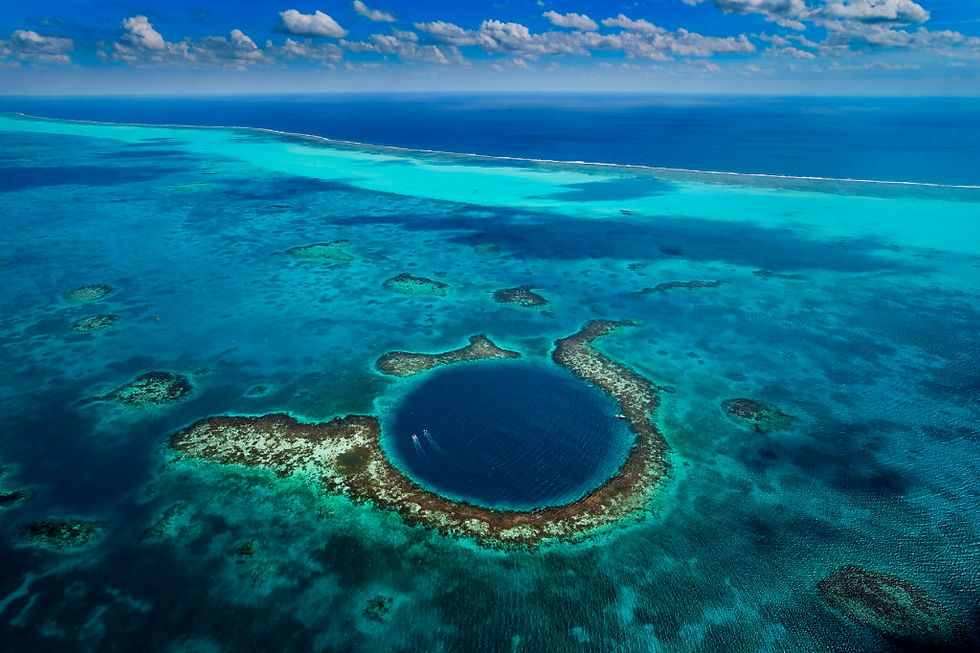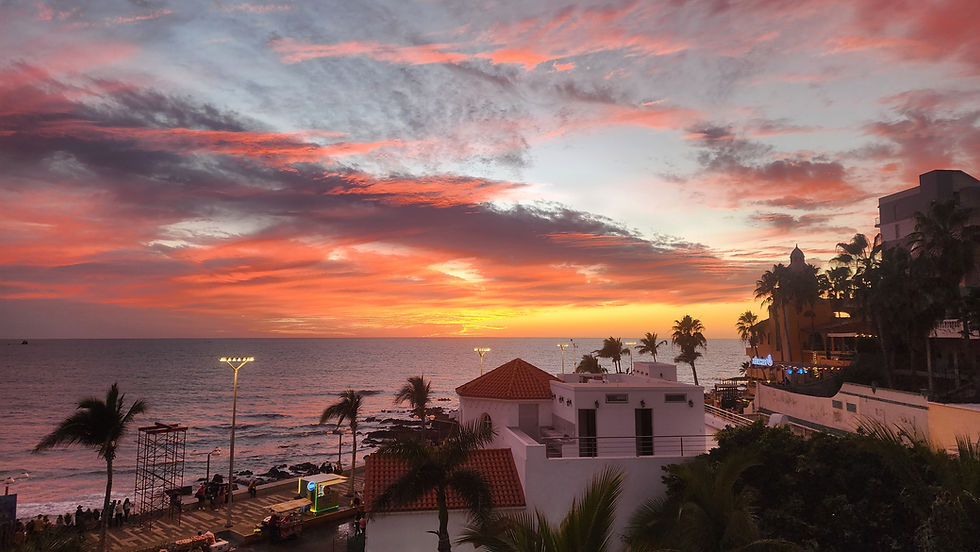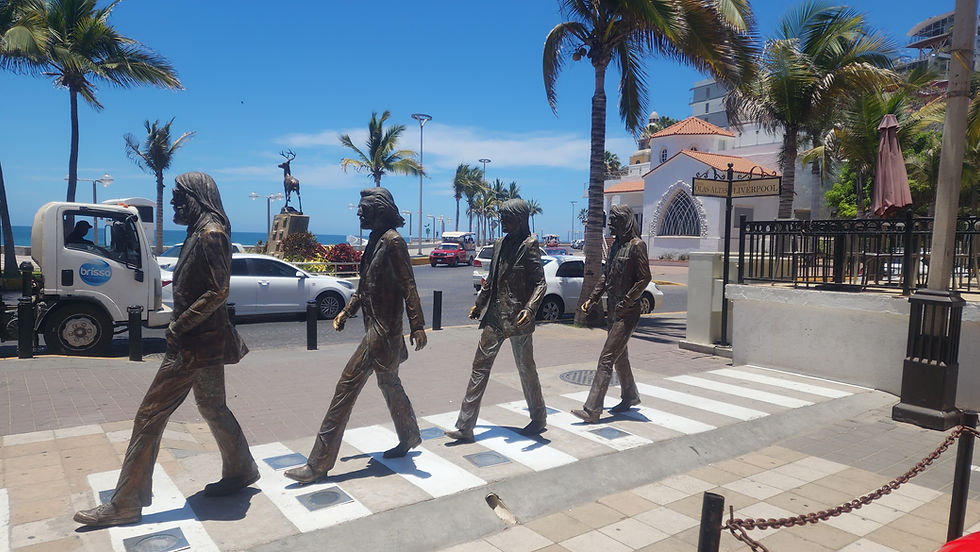Dive! Dive! Dive!
- Bil
- Jun 11, 2022
- 9 min read

Tourism here on Ambergris Caye, as in most of the Caribbean, is driven by rum served under thatched roof bars (called palapas in Belize)! If you have met me, you know this is right up my alley, so we had to check out the Nauti Crab, where they feature a myriad of exotic rum drinks, local food and X-rated crab races!
When we arrived the MC, who was wearing a snappy crab beanie, was announcing that signup would commence shortly at 6 pm, so get ready to pick out your beast and give her a name. His running commentary was hilarious. By the time Susie & Skylar got their turn only a handful of hermit crabs remained in the bucket, and they seemed to be moving slowly. Probably conserving their strength. Picking out a muscular looking specimen, they gave her the moniker of Queen of Claws and plunked down $5!
Once everyone has made their bets the MC puts them all under an OHIO State bucket, then removes it so they can all dash (haha) to the outside of the 5’ ring, maneuvering around obstacles such as a boat bumper, conch shell, stuffed crab toy, while the MC calls out a play-by-play with plenty of jokes thrown in. First one to crawl over the rope perimeter wins. Many of the crabby names were R or X rated, but there were some clever ones – my fav was Ruth Pinchburg! The Queen did not Win, Place or Show – but we still had a lot of fun.
Tourism here is also driven in a large part by the amazing Belize Barrier Reef, part of the Mesoamerican Barrier Reef System. This system of underwater coral reefs stretches over 700 miles from the northern tip of the Yucatan to the Bay Islands of Honduras. More than 500 species of fish, 350 species of mollusks and 65 species of stony corals live along this system, including manatees, lionfish ☹, crocodiles and whale sharks.

After Skylar joined us, we wasted no time in booking some dive trips to explore the amazing reef system just offshore. I had already done an easy dive at Hol Chan Marine Reserve with Belize Pro Divers the week before, so Skylar & Susie signed up for that to get “back in the saddle”, while I did two morning dives at another location.
When the dive boat arrives at Hol Chan they pull up to a floating office where a park ranger collects a 10 USD fee and issues wristbands. The boat then hooks up to one of the available mooring buoys – no anchoring allowed to protect the coral. Time to suit up and roll in backwards. Sky deflated her BC and descended to the 30’ coral bottom below, whilst Susie stayed on the surface with the snorkelers. After a 40-minute dive they motored a short way to Shark & Ray Alley where everyone used snorkels to swim with the swarm of large nurse sharks, rays, jacks and snappers, looking for the expected handout from the captain. Totally (well, usually) harmless but thrilling nevertheless.
Two days later Skylar and I did two nice morning dives when the wind was mild and seas were calm. The captain drove us to San Pedro Canyons, diving to 78’ where the water temp was 82°. The constant change of tides over the centuries has cut channels through the coral where the depth may vary 30’ from the coral tops to sandy bottom. Joe, our divemaster, was always pointing out creatures we would have missed, such as tiny crabs or shrimp inside coral tubes, strange fish & rays buried in the sand and husky reef sharks circling us 30’ away.
These were my first dives with a dive computer: an entry-level Cressi Giotto that monitors depth, time, safety stops, surface interval, etc., and can upload to my PC. Eliminates the need for using the dive tables to calculate bottom time per depth. Worked pretty well, but the PC interface is crude & finicky. I also used Nitrox for these dives – not to extend bottom time as I had to follow the group – but as Nitrox adds a safety margin for nitrogen release, and possibly reduces fatigue in older divers. Not that I would need that, hehe, but why not! I do not have an underwater camera so have to get photos from fellow divers or find on the ‘net for relevant items of interest.

Deciding to take advantage of the good weather we signed up for the night dive that same evening, which was going back to Hol Chan to see the different underwater activity after dark. Tying up to the mooring buoy at 6:15, we watched a gorgeous sunset while getting our briefing and waiting for the sky to darken. There were 5 or 6 other small dive boats in the area as well.
Dropping into the warm water and descending to the shallow bottom, Joe checked everyone’s flashlights and then led us off through the coral. Many sea creatures become more active at night, and we did see more crabs scuttling along the bottom and big rays flapping through the water column. I was enthralled watching two large Cubera snapper (maybe 30 lbs) on the hunt, their goldish-purple scales flashing in the beam of my light. They would wriggle through impossibly tiny crevices chasing smaller fish, and I saw each of them finally grab a hapless angelfish or smaller snapper, and swim away with it.
The tide was starting to come in, forcing us to use some power to swim through the sandy cut between the coral ledges. A couple of areas were swarming with plankton & blood worms, reflecting our light beams and reducing visibility. The blood worms were really attracted to the light and focusing on a coral or anemone would attract the worms and feed the coral! Also, they supposedly can get in your ears – not dangerous, but creepy & irritating.
And the coup-de-grace, what everyone hopes for: we saw a beautiful octopus stretching on a coral head, and it crawled around for a minute of two before slipping away into a tiny crevice. Magnificent.

The trade winds steadily increased over the following days, so we were unable to dive any more before Sky returned to Miami. There was time to sample a few more eateries, and we enjoyed some nice meals at the newly opened Southern Charm right across the street and La Divina, home of the pupusas. Another favorite was Robin’s Kitchen, a tiny shack with a couple of picnic tables and a grill that served the best jerk chicken, slaw and rice’n’beans for $7. Next to them was the always-busy Hill’s Produce and Las Paletas where we bought organic fruit paletas (local “popsicles”) by the dozen, in flavors of Strawberry Mojito, Peanut Butter, Pina Colada and Mango. Yummy!
Checking back at Belize Pro Divers, they said there was a window of good weather on Saturday and a boat would be making the long trip out to the Blue Hole. This was one dive I wanted to make, made famous by childhood hero Jacques Cousteau, so sign me up! When Luis picked me up in their small boat at 5:30 am the wind was not bad, but a dark squall line hung over the reef as far as I could see. The rain started shortly after we arrived at the dive center but stopped (temporarily) before boarding the triple Yamaha 200 powered dive boat.

The trip out to the Lighthouse Reef Atoll took about two and a half hours, alternating between choppy water inside the reefs and pounding through a rough quartering sea in the blue water, with increasing wind and rain. Everyone was thoroughly chilled and soaked when we finally arrived about 8:30, and the sun was actually trying to peek out.
The Blue Hole was formed as a typical karst limestone cave when sea levels were much lower, starting about 155,000 years ago. Several periods of glaciation raised the oceans and flooded the cave, and stalactites, stalagmites and ledges were formed at different levels. Today the marine sinkhole is 1,043’ across and about 407’ deep.
Scuba diving along an almost vertical wall, and swimming through giant stalactites is the main attraction here, and it was awesome. It is a very strange feeling to look up 136’ to the surface, and look down to total darkness, without seeing the bottom. Everyone enjoyed the dive and no one got “narced out” out from the depth, so it was a successful dive!
Next up was a 20-minute ride across shallow water to Half Moon Caye at the south end of Lighthouse Reef where we had some snacks while waiting for the hour of surface interval to expire. Back in the water for an 86’ dive on Half Moon Caye Wall, with many varieties of beautiful corals and sponges. One inquisitive loggerhead turtle followed us for a while, coming head-on within inches of my mask before slowly veering away. Also a huge green turtle sleeping on the bottom.

When I surfaced, I really had to pee, but never felt relaxed enough while getting to and into the boat. We ran back to the docks at Half Moon Caye where the crew set up a nice typical lunch of BBQ chicken. There was a ranger station and bird sanctuary on the island, and plenty of hermit crabs on the sandy paths. I made a stop at the bathroom before getting back on board – still no go. Hmmmm.
Another short ride to the Aquarium, a lovely site with a 50’ wall and beautiful coral ridges running parallel to it. There was an abundance of tropical fish and corals, and we saw 2 green morays swimming freely through the coral heads, and a sleeping nurse shark. As we rose to 15’ for our 3-minutes safety stop, the urge to pee became more insistent but nothing was happening. Ugh.
Benign prostatic hyperplasia (BPH) — also called prostate gland enlargement — is a common condition as men get older, and I have been tracking it for a few years. Main effect so far has been getting up at night to urinate, but suddenly alarm bells are going off in my head. What if the pressure from diving has caused the prostate to swell enough that it has completely blocked the urethra? Sounded logical but felt painful!
So, I spent a good part of the rough 2.5 hour return trip in the tiny head, bracing with one hand and trying to relax. Yeah – right. No joy. And just to make it worse, the dive masters were mixing up plenty of rum & cokes for the divers! Arg. Finally getting home and hurting pretty bad, we bounced into San Pedro in the golf cart to the tiny free clinic.
They took some basic information and inserted a catheter, and finally…..relief! The doctor prescribed some alpha-blockers to relax the muscles around the prostate, gave me a fist bump and off we went. No charge! All has been well since, but I am currently trying to figure out the best way to get a comprehensive exam – Mexico or US. Best care vs convenience. Insurance $$$. All that fun stuff.

Sargassum has become a huge problem all over the Caribbean over the last 10 years. My past experience with this reddish-brown floating seaweed (macroalgae) had been positive – when out trolling for dolphin (aka mahi-mahi or dorado) in deep water, a weed line of sargassum often meant larger fish nearby, feeding on the small fish & crustaceans living in the biomass.
Since 2011 the amount of sargassum washing up on Caribbean shorelines has increased dramatically, costing millions of dollars in cleanup measures and lost tourism that most small countries can ill afford. Likely causes are increased nutrients and pollution from the Amazon River and tributaries to the Gulf of Mexico, rising ocean temperatures and phosphates & iron from North Africa.

During our first 2 weeks here, the onshore wind kept blowing more of the seaweed towards us until there was a floating mass extending about 50 yards out. When it starts to decompose the sargassum consumes oxygen, resulting in fish kills. It also releases hydrogen sulfide gas which not only smells awful but is harmful to people with respiratory problems. The caretakers along the beachfronts would use everything from rakes & wheelbarrows to backhoes and specially made machines for scooping up the piles of seaweed and hauling it off. 4 weeks after we arrived the wind freshened and shifted slightly to the north and blew it away from our beachfront.
We have thoroughly enjoyed our time in Belize! The people are so nice and friendly, and having English as the official language makes life easier. There are a lot of Americans here and more moving down every day. Some move back after a year but most prefer the tropical vibe and slower pace, finding a home in this warm community.
Well, Dobby the house gecko is chirping from his hiding place near the ceiling, so that means it is time to turn out the lights.
Sending a big shout-out to all the wonderful people we have met during our two months in Belize! Placencia: Kyree, Theo & Beatrice, Jennifer; San Ignacio: Maria, Seidy; Ambergris Caye: Mark & Nancy & Patches, Roger, Baris & Sondrea, George & Jody, Sean & Becky, Mike & Shelly; the pickleball gang: Jason, Maria, Nancy, Heri, Giselli, Gerri & Taylor; and all the folks at Belize Pro Divers!








Another amazing voyage into another speck of paradise.